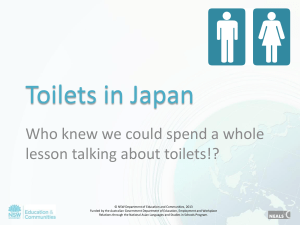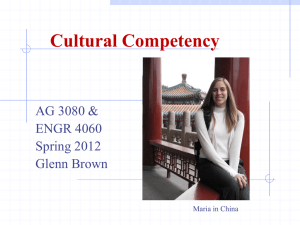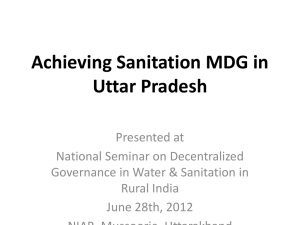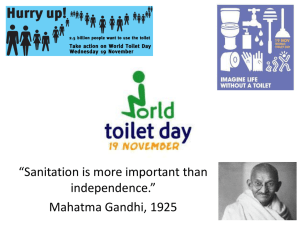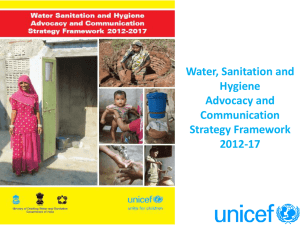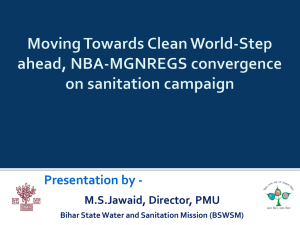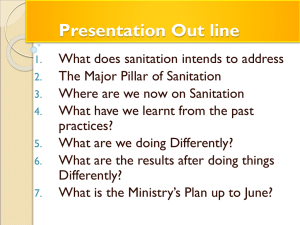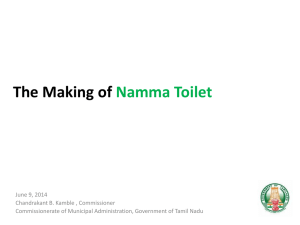gautam.anupaudyal_finalppt_2014
advertisement
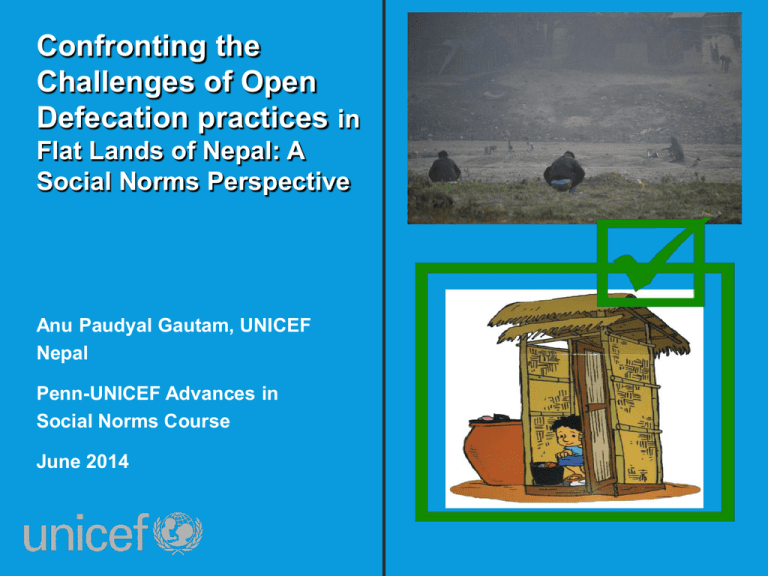
Confronting the Challenges of Open Defecation practices in Flat Lands of Nepal: A Social Norms Perspective Anu Paudyal Gautam, UNICEF Nepal Penn-UNICEF Advances in Social Norms Course June 2014 Where are we Sanitation Coverage Universal access target 100 Additional performance required 90 70 National Coverage (%) National Coverage (%) 80 MDG target 60 50 40 30 20 10 0 1990 1995 2000 2005 2010 2015 Year Source: MPPW 3 2020 Sanitation-Universal Coverage and MDG Target 100 Universal access target 90 More Efforts Essential 80 70 CENSUS - 62% 60 MDG target 53% 50 40 30 20 10 0 1990 1995 2000 2005 2010 2015 2017 2020 2022 Key Sector Challenges Population served and unserved with Toilet facility Pop with Latrine Pop practicing Open Defecation 2.0 mil H/Hs (38%) 3.8 mil H/Hs (62%) H/Hs with Improved, Unimproved and OD Improved Unimproved/Ordinary Without Toilet 2,069,812 , 38% 2,262,652 42% 1,055,862 20% Functional and sustainable Status?? Source: Census 2011 6,000,000 H/Hs with Assets vs Latrine (CENSUS 2011) [61.83%] [50.82%] 1,000,000 [32.38%] 1,756,243 [36.85%] 1,976,603 2,000,000 5,423,297 3,000,000 3,504,929 [64.63% ] 2,756,325 4,000,000 The attitude towards toilet is poor as people feel that having a television, radio and mobile is a status symbol. Latrine is not perceived as a prestige driver. 3,353,225 5,000,000 Total H/Hs H/Hs with Mobile H/H with Latrines H/Hs with Radio H/Hs with TV H/H with Cycle SOCIAL NORMS PERSPECTIVE Is Open Defecation a social norm issue The answer is no because Conditional Preferences Individuals perform this act to meet their needs Which are guided by unconditional preferences Social Norms Empirical Expectations Normative Expectations SOCIAL NORMS DIAGNOSIS (I) Non-ODF communities Factual Beliefs Open defecation is not harmful Children feces is not harmful Children get diarrhea when they are tootling Latrine is expensive No knowledge about diarrhea cause ODF communities Factual beliefs People were eating their own shit and the shit of others Shit is the main cause of diarrhea It is a matter of shame and disgust (Shame elicits expectation of what others think I do) EXCEPTIONS (MOSTLY IN TERAI) Women feel shy while using the toilet thinking what other people might think. However, they don’t feel ashamed while doing it near a lake or a pond A female hesitates to use the toilet being used by her father in law (mahisoor) and brother in law (bhaisoor). 'How can we defecate over somebody else’s excreta? (haglay pay hagoo)', a common belief of people in community. In Tarai while digging 4/5 feet for making the toilet hole, water seeps in and the hole gets filled very soon. So it’s a hassle/expensive to clean the pit Peoples believe that defecation in the field is necessary for the fertility of the soil. SOCIAL NORMS DIAGNOSIS (I) Non-ODF communities ODF communities Personal normative beliefs Latrine is more for women than Personal normative beliefs men Defecating in the open is good Latrine construction is my I can save money for other things personal social Latrine construction is a waste of responsibility money It is a matter of prestige Latrine is government’s and pride responsibility Hurdle to wait in queue to use Everbody in the family will toilet especially in larger family use the toilet Feeling suffocated inside the toilet. SOCIAL NORMS DIAGNOSIS (II) Non-ODF communities EE People expect that some will do OD and some will not do OD (positive deviance) ODF communities EE NE Normally there is no normative expectation around open defecation practice People see that people around them have build toilets (What I think other do) People do not see anyone doing open defecation in the open space NE People believe that everyone else think that I use a toilet should use (What I think others think I should do) NEW SCHEMA AND SCRIPT Families maintain toilet Schema An ideal family is one which owns and uses a toilet Scripts Girls marry boys having toilet at home Keeping Surroundings clean and free from flies Use of toilet by all family members Disposing off child feces in the toilet Latrine is used and cleaned by male members of the family CRITICAL EVALUATION OF PAST WORKS 1. 1980s –WATSAN decade – Sanitation as a weak add on to Water Supply projects 2. 1990s –Sanitation Policy 1994, Child to Child Approach 1997, Steering committee for National Sanitation action formed in 1998 3. 2000s - Initiated School Sanitation and Hygiene Education program, School Led Total Sanitation program 2006, International Year of Sanitation and Global Hand Washing Day in 2008 4. 2009 - Aligning for Action and Sanitation Social Movement in Nepal SUCCESSES AND FOUNDATIONS OF NEW NORM Significant increase in the sanitation coverage (6% in 1999 to 62% in 2011) Accelerated achievement of Open Defecation Free communities (Reference Network) Enabling legislative provisions - National Sanitation and Hygiene Master Plan, MAF for sanitation with UNICEF support (Harmonization of legal and social norms) Sector harmonization and partnership (Everybody coming together) Government leadership and community ownership Institutional set up and arrangements (Organized Diffusion LESSONS Subsidies didn't work (community emotions was not triggered) Reversion to OD in some areas due to lack of water (extra social norm) Use of coercion by the authorities to promote household toilet construction has been challenged WHAT WORKED ? (I) Information shared within the entire community about the negative consequences of OD for all Collective change of factual beliefs and attitudes (elicit disgust through Triggering already lead to normative expectations and pride and prestige linking the behavior with social status) Collective decision to enact change (coordinated action) Realize social dilemma problem: “Norm creation“ Spontaneous diffusion WHAT WORKED (II) Flagging (Green flag is hoisted to declare ODF – this already creates normative expectations and future conformity to the behavior Public Declarations from highest political level (Enough people are seeing that enough people are changing which are the foundational capacity for reference network) THE NEW PROJECT CELEBRATING EVERYDAY HEROES A Comprehensive Communication for Development Strategy EVERYDAY HEROES COMMUNICATION STRATEGY: AT A GLANCE KEY BEHAVIOURAL RESULTS IMPLEMENTATION MODALITIES Pregnancy care Planning & Coordination New-born care Postnatal Care Infant and Young Child Feeding HIGH INVESTMENTMENT COMPONENTS Advocay & Partnership Role models as Everyday Heroes Capacity Strenthening Children for Change: Community Mapping Media Engagement Engaging Men for Equality Community Mobilization Hygiene Social Mobilization Protection and Education CROSS CUTTING DIMENSIONS Inclusion v Participation v Social Norms v Empowerment Participatory EntertainmentEducation GOING BEYOND CAP – RESULTS OF FORMATIVE RESEARCH FROM DHANUSHA • Ideal behavior All family members should use toilet at all times Guardians should explain their children and others about the importance of using toilet. Elder members should develop the habit of using toilet at all times so that the What the responder does What the responder believe other s do • Developing the habit of using toilet • Giving pressure to others in the community for using toilet and aware them about the What the importance of using toilet responder does she should do What the responder believes others think she should do Normative Expectations Setting a community-wide rule for every households in the community to build and use toilets Establishing a committee and levy a fine (‘jurmana’ and ‘kar’) or social punishment against those who defecate in the open. STRATEGY COMPONENTS C4D Strategy Measuring Social Norms Behavioral Monitoring Plan Costed Implementation plan Creative Strategy A Story-world IVR PR PSAs Multiple media entry points Radio Local FMs segments Comm. Theater A story-world: A shared universe where settings, characters, objects, events, actions of one or more narratives exist. Social Media A differentiated path to stories responsive to audience/platform Web series IPCC materials Comic strips Network Analysis for Organized Diffusion Red - central node (Local Development Universal access target Officer/Nominated Additional Chairperson) performance Green – Village Head required Yellow – High Degree nodes Mustard – Villages DWASH Sanitation Coverage CCs 100 DWASH CCs 90 70 National Coverage (%) National Coverage (%) 80 MDG target 60 50 40 30 20 10 0 1990 DWASH CCs 1995 2000 2005 2010 2015 Year Source: MPPW 25 2020 SUSTAINABILITY An Open Defecation Free Nepal Humla Darchula Bajhang Bajura Mugu Baitadi Dadeldhura Doti Kalikot Achham Dailekh Kanchanpur Jumla Dolpa Mustang Jajarkot Kailali Rukum Surkhet Salyan Bardiya Banke Rolpa Manang Myagdi Baglung Pyuthan Dang Kaski Lamjung Gorkha Parbat Gulmi Arghakanchi Syangja Rasuwa Tanahu Dhading Palpa Kapilbastu Rupandehi Nawalparasi Nuwakot Sindhupalchoke Kathmandu Bhaktapur Kavre Chitawan MakwanpurLalitpur Parsa Dolakha Solukhumbu Taplejung Sankhuwasabha Ramechhap Okhaldhunga Sindhuli Bhojpur Terhathum Panchthar Khotang Bara Rautahat Udayapur Dhankuta Sarlahi Mahotari Ilam Dhanusa Siraha Sunsari Morang Jhapa Saptari Thank You! Thank You
